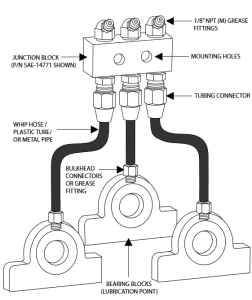Remote lubrication systems are the best solution for accessing hidden or guarded grease fittings in hard to reach or dangerous areas, and they even make the job of keeping them lubricated quick and easy as well! Remote lubrication systems can be configured in almost infinite configurations, but the core equipment required includes: a Junction Block, Tube Connectors, Bulkhead Connectors, and Hose or Tubing.

Always invest in a remote lubrication system whenever you find yourself in a situation where you need to disassemble equipment or torque your body in inhumane positions to access grease fittings. First-time setup takes a little extra time, but the time spent is well worth the effort and time saved in the long run! Once the remote lube system is setup you simply dispense a few pumps of grease at the easy-to-access junction block to lubricate multiple hard-to-access grease fittings.
Setting up a remote lubrication system is simple if you follow these steps.
- Choose a Junction Block that meets your needs from a selection primarily based on the number of fittings you need to access (1-6) and the size of the mounting hole (11/32” or 9/32” diameter).
- For mobile machinery applications, choose a location somewhere on the machine itself.
- For static equipment applications, a mounting location can be selected that is one the equipment or up to 40 feet away. It is not uncommon to service multiple machines from a single junction block.
- Identify the ideal mounting location so that you can easily access the fittings but also keep the system out of the way of any other moving parts. Mount the junction block with the screws provided using the mounting holes on the block. NOTE: make sure the holes for the grease fittings are on top.
- Install 1/8” NPT grease fittings into the holes provided on the top of the junction block. NOTE: Junction blocks are for 1/8” NPT grease fittings only.
 Choose a Tube Connector size to match the tubing size that will run from the junction block to the equipment. Screw the tube connectors to the bottom of the junction block to accept the grease from the fitting above. There are both straight and 90-degree tube connectors to choose from.
Choose a Tube Connector size to match the tubing size that will run from the junction block to the equipment. Screw the tube connectors to the bottom of the junction block to accept the grease from the fitting above. There are both straight and 90-degree tube connectors to choose from.- Determine what type of Hose or Tubing is required for the application (1/8” or ¼” diameter).
- 304 Stainless Steel Tubing is ideal for corrosive environments and has working pressures up to 9000 psig.
- Feed Line Hose is made from Nylon tubing with dacron braid and polyurethane cover. These hoses are pre-filled with NLGI grade 1 grease and do not require priming. They can withstand working pressure up to 4000 psig.
- Steel and Nylon Tubing are also available in both sizes and options for pre-filled or empty (requires priming to fill the tube when selecting unfilled). Nylon tubing has a temperature range of -60°F to 200° Steel tubing can withstand higher working pressures up to 4400 psig.
- After the selected hose is attached to the tube connector at the junction block, you will need to run a hose to each lubrication point on the equipment. Be sure to secure the hose in such a way that it does not interfere with the equipment itself.
- Now it is time to remove the grease fitting from the lubrication point on the equipment and replace with a Bulkhead Connector or Feed Line Swivel depending on whether you need the connection to be static or allow from swivel motion during remote greasing.
- Lastly, connect the Feed Line Hose to the Bulkhead Connector and the remote lubrication system is complete.
Contact Us if you find yourself straining to lubricate difficult to access grease fittings and we’ll provide a solution that makes the job quick and easy.
